Bird Research News from Nial Moores and Bernhard Seliger
Surf Scoter, Relict Gull, almost 2,000 Long-tailed Duck, several Steller’s Sea Eagle, Ural Owl and probable Water Pipit were some of the outstanding highlights out of 102-103 species recorded during this third survey of avian biodiversity in Rason in north-easternmost Korea, close to the border with China and Russia.
 Adult male Surf Scoter Melanitta perspicillata (on right) between two White-winged Scoters, Sonbong, Rason © Nial Moores
Adult male Surf Scoter Melanitta perspicillata (on right) between two White-winged Scoters, Sonbong, Rason © Nial Moores
Funded by the Hanns Seidel Foundation (Korea) with the logistical support of local bodies and of Michael Spavor (Paektu Cultural Exchange), this early winter survey followed on from surveys in March 2014 and July 2016.
Covering two forested areas, some areas of open reed and grasses and c. 12 count areas along the Rason coast in weather that ranged from clear, calm and cold to overcast with heavy snow on two dates, the results help to confirm once more the outstanding importance of this area to migratory birds and the area’s potential for birdwatching-based ecotourism in line with international conservation approaches.
 View from top of Sahyangsan, above Najin City, including the rocks where we found a flock of Alpine Accentor © Nial Moores
View from top of Sahyangsan, above Najin City, including the rocks where we found a flock of Alpine Accentor © Nial Moores
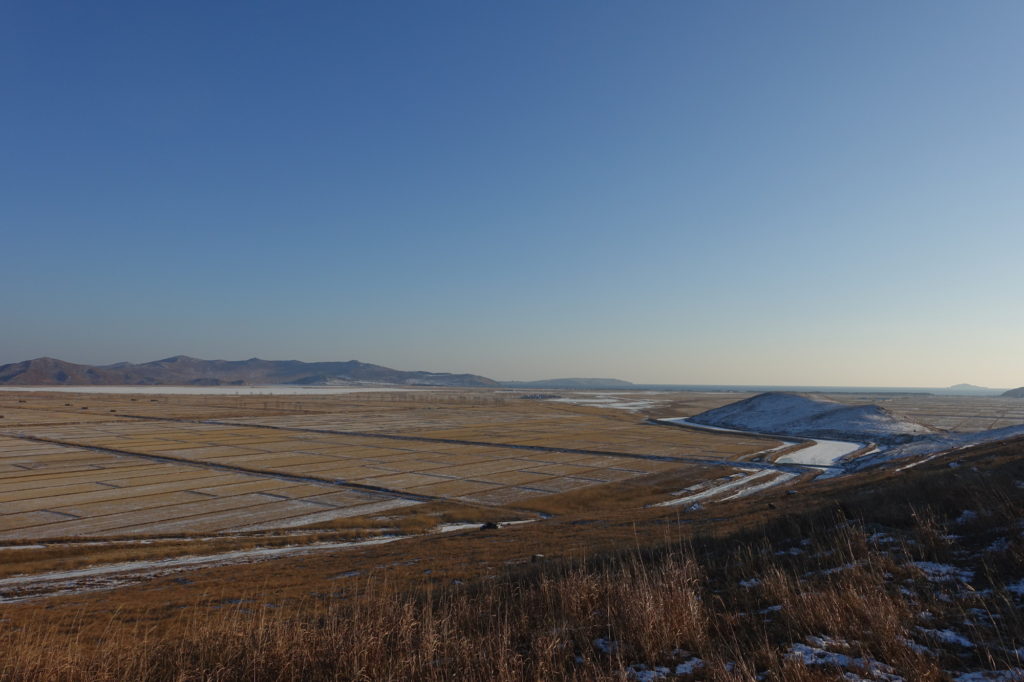 View from “Snake Mountain” towards Sobonpo, Rason. Behind the line of hills lies the Tumen River and the border with Russia and China © Nial Moores.
View from “Snake Mountain” towards Sobonpo, Rason. Behind the line of hills lies the Tumen River and the border with Russia and China © Nial Moores.
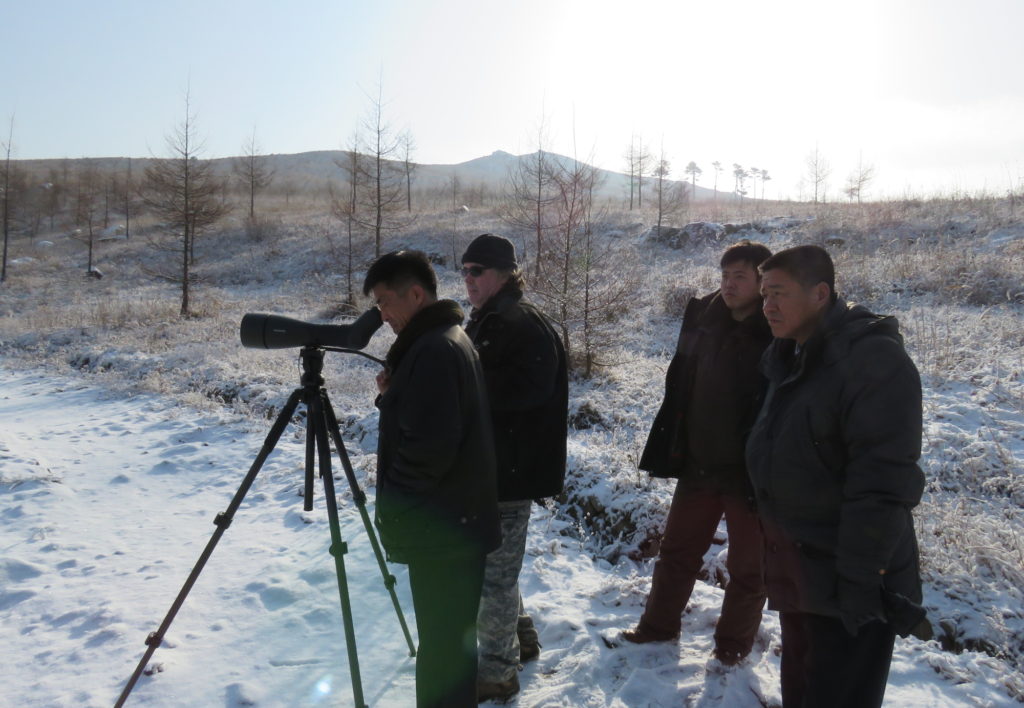 Looking at buntings (always in the still unfulfilled hope of finding a Jankowski’s here…) with our increasingly interested and sharp-eyed “guides” © Bernhard Seliger.
Looking at buntings (always in the still unfulfilled hope of finding a Jankowski’s here…) with our increasingly interested and sharp-eyed “guides” © Bernhard Seliger.
Some of the most notable taxa and numbers follow:
Mute Swan Cygnus olor. Two remained in one of the only patches of open water on Sobonpo.
 Mute Swan (with Eurasian Wigeon), Sobonpo, Rason © Nial Moores
Mute Swan (with Eurasian Wigeon), Sobonpo, Rason © Nial Moores
Harlequin Duck Histrionicus histrionicus. A total of 57 were counted along the Rason coast.
 Harlequin Duck, Pipa Islet, Rason © Bernhard Seliger
Harlequin Duck, Pipa Islet, Rason © Bernhard Seliger
Surf Scoter Melanitta perspicillata. An adult male was digiscoped at long range just west of Songbong on the 27th as it pursued a White-winged Scoter. This is presumably the first record of this North American species in Korea. In adjacent regions, Brazil (1991) traced only 11 records of Surf Scoter from Hokkaido and Northern Honshu up to 1990, and the species is not listed in a 2010 checklist of the birds of Primorsky Krai (Far Eastern Journal of Ornithology, No. 1 2010).

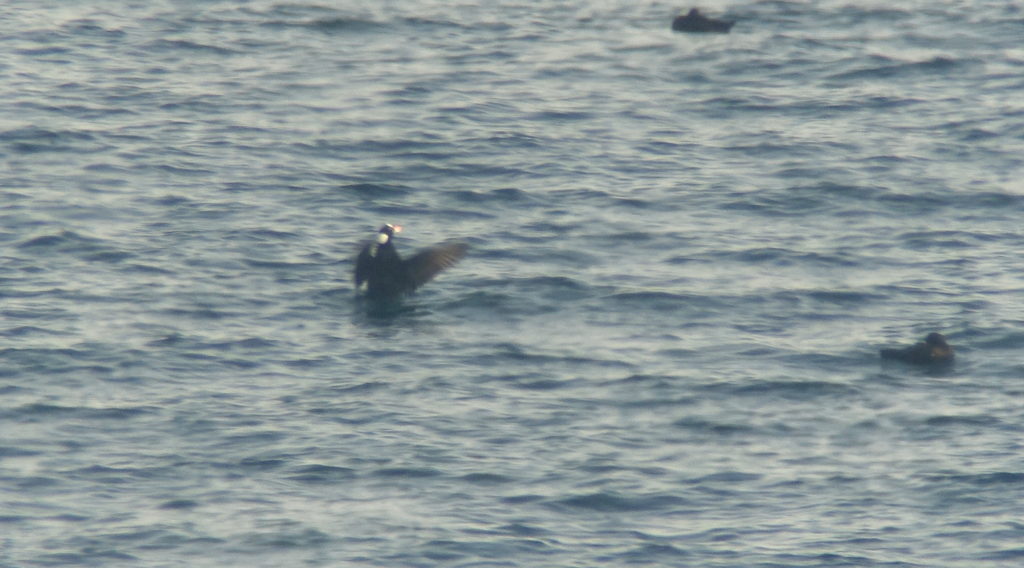 Surf Scoter, Songbong, Rason © Nial Moores
Surf Scoter, Songbong, Rason © Nial Moores
White-winged Scoter Melanitta (deglandi) stejnegeri. We recorded more than 4,000 during the present survey, equivalent to 1% of the lower end of the global population estimate of 400,000-700,000 made by BirdLife International (2016). Our counts far exceed the numbers listed in Tomek’s review of the ornithological literature of the northern provinces of Korea (Tomek 1999) and support the opinion of Fiebig in 1993 (in Tomek 1999), who suggested that flocks of several thousand can be found along the eastern coast of the DPRK. The species appears to be undergoing a rapid decline in the ROK.

 White-winged Scoters, Rason coast © Nial Moores
White-winged Scoters, Rason coast © Nial Moores
American Scoter Melanitta americana. A conservative total of 200 were logged.
Long-tailed Duck Clangula hyemalis. We recorded almost 2,000 in the present survey and no doubt missed many more that were further offshore (occasional lines were visible out in the “heat haze”). Tomek (1999) traced only 13 records from the DPRK; and the species is still scarcely recorded annually in the ROK. The northeast of Korea might therefore prove to be internationally important for this species which has recently been uplisted to globally Vulnerable based largely on rapid declines in the population wintering in the Baltic Sea. The number of birds wintering in East Asia remains poorly known (BirdLife International 2016).

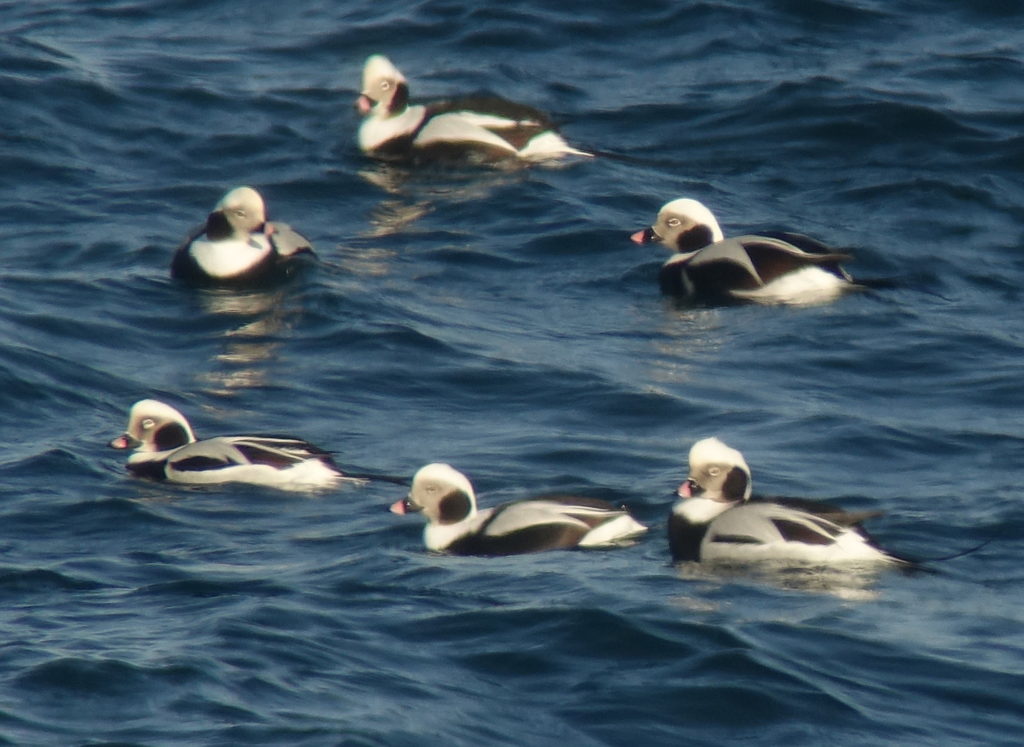

 Long-tailed Ducks, Rason Coast © Nial Moores
Long-tailed Ducks, Rason Coast © Nial Moores
Japanese Quail Coturnix japonica. A total of seven of this globally Near Threatened species were logged in reedy grassland close to Uam on the 26th.
Common Pheasant Phasianus colchicus. Widespread, common and often quite approachable (with 65+ logged during the present survey), suggesting that this species experiences little (if any) hunting pressure in Rason. Presumably birds belong to the subspecies pallasi?
 Common Pheasant, Tumangang Maul, Rason © Nial Moores
Common Pheasant, Tumangang Maul, Rason © Nial Moores
Pacific Loon Gavia pacifica. We recorded at least two during the present survey. Oddly, the species is not listed by Tomek (1999), even though it can be locally numerous in the ROK.
Horned Grebe Podiceps auritus. We recorded 40 during the present survey. Tomek (1999) provided only five records for the DPRK (most made by Fiebig); and the species has recently been uplisted to globally Vulnerable by BirdLife International (2016).
Northern Goshawk Accipiter gentilis. A total of five different Northern Goshawk were recorded during the present survey, four of which were First Calendar-years. All appeared to be pale-end schvedowi, though one especially small individual might have been fujiyamae.
 First Calendar-year Northern Goshawk, Tumen River, Rason © Nial Moores
First Calendar-year Northern Goshawk, Tumen River, Rason © Nial Moores
Steller’s Sea Eagle Haliaeetus pelagicus. We recorded a total of 3-4 individuals of this globally Vulnerable species during the present survey, including one dark morph very poorly digiscoped on the 27th as it sat out in the Tumen River. Although only seen at distance, this bird appeared to lack any trace of white in the plumage but did show extensive black on the bill tip, typical of First Calendar-years. We did not see the bird in flight. We also saw one distant First Calendar-year (perhaps together with a subadult?) sitting out on SonbonPo on the 28th; and one First Calendar-year in flight over Sahyangsan on the 29th.
 Dark morph Steller’s Sea Eagle, Tumen River, Rason (Russia in background…) © Nial Moores
Dark morph Steller’s Sea Eagle, Tumen River, Rason (Russia in background…) © Nial Moores
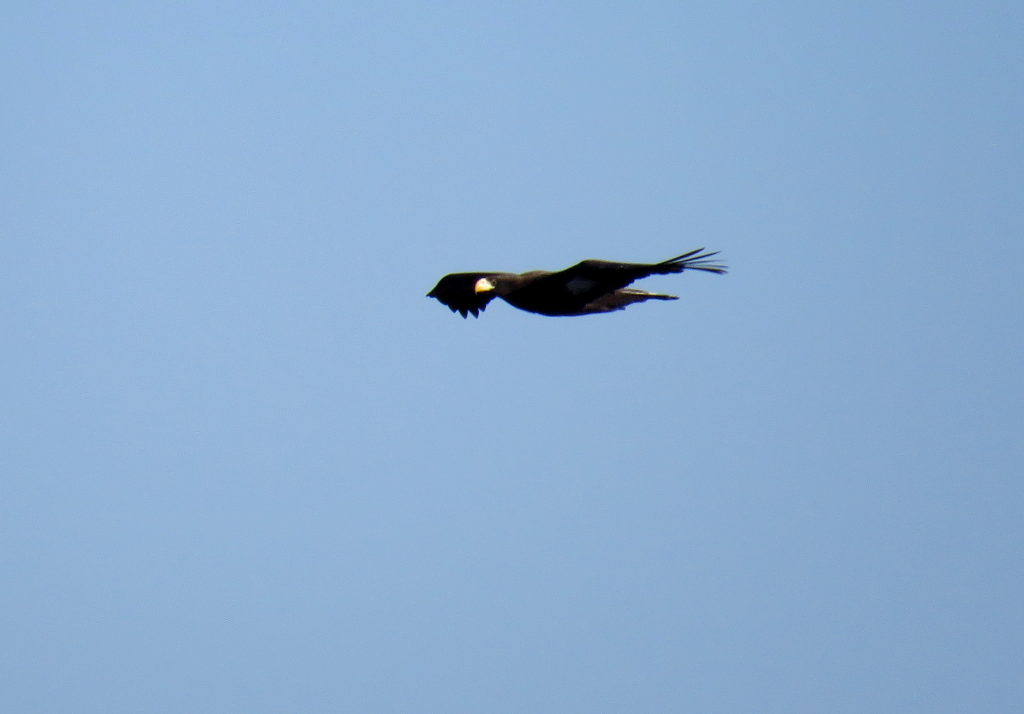
 More typical First Calendar-year Steller’s Sea Eagle in flight over Sahyangsan, Rason © Bernhard Seliger
More typical First Calendar-year Steller’s Sea Eagle in flight over Sahyangsan, Rason © Bernhard Seliger
Rough-legged Buzzard Buteo lagopus. Although Tomek (1999) states that this species was recorded “scarcely ten times” from the northern provinces of Korea “by the end of the eighties”, we recorded at least ten in total during the present survey, most concentrated close to the (inaccessible) Tumen delta.
 Rough-legged Buzzard, Uam, Rason © Nial Moores
Rough-legged Buzzard, Uam, Rason © Nial Moores
Relict Gull Ichthyaetus relictus. We recorded three First-winters together on the ice at Gulpo on the 26th, and four First-winters together there on the 27th. This is only the second record of this globally Vulnerable species in the DPRK, with the first record being of five in the same area in late March 2014 (UNESCAP & Hanns Seidel Foundation 2014).
 One of the four First-winter Relict Gulls at Gulpo, Rason © Nial Moores
One of the four First-winter Relict Gulls at Gulpo, Rason © Nial Moores
Common Gull Larus canus. We found no substantial concentrations of gulls – and no Black-tailed Gulls – and Common Gull was therefore marginally the most numerous gull species recorded during the present survey even though we only logged eighty or so individuals. All immature birds that were seen well were of subspecies kamtschatschensis.
 Second-winter Common Gull of subspecies kamtschatschensis, Najin, Rason © Nial Moores
Second-winter Common Gull of subspecies kamtschatschensis, Najin, Rason © Nial Moores
Glaucous Gull Larus hyperboreus. Forty-four were logged during the present survey, similar to the total of 40 recorded during rather less intensive survey in March 2014.
 Glaucous Gull, Gulpo, Rason © Nial Moores
Glaucous Gull, Gulpo, Rason © Nial Moores
Slaty-backed Gull Larus schistisagus. A total of 17 were logged during the present survey. Tomek (1999) traced only nine DPRK records in total, and suggested that the species was likely earlier overlooked by ornithologists as it was in the ROK.
 Slaty-backed Gull, Najin, Rason © Nial Moores
Slaty-backed Gull, Najin, Rason © Nial Moores
Common Murre Uria aalge. Two were seen from Uam on the 28th.
Spectacled Guillemot Cepphus carbo. A total of 13 were found along the coast, compared with the 26+ we counted here in July. Tomek (1999) did not trace any records between September and February.
Hill Pigeon Columba rupestris. Ten were seen in flight at Tumangang Maul on 28th.
Ural Owl Strix uralensis. One was seen (and digiscoped) at the foot of Sahyangsan on 26th. Tomek (1999) traced only 8 records, two of which were historical records (in 1912 and 1920) from Hamgyong North. All more recent records were from Ryanggang. However, the species was “frequently found” at Myohyang during 2001-2003 (Duckworth & Moores 2008), and also appears to be an extremely local but regular breeder as far south as southern-central Gangwon Province (Birds Korea archives).
 Ural Owl, Sahyangsan, Rason © Nial Moores
Ural Owl, Sahyangsan, Rason © Nial Moores
Japanese Pygmy Woodpecker Dendrocopos kizuki. One rather pale-plumaged bird (presumably of subspecies permutatus?) was seen close to Pipa Island on the 29th. Although considered to be common throughout the country by Tomek (1999) this was the only individual that we recorded during the three surveys.
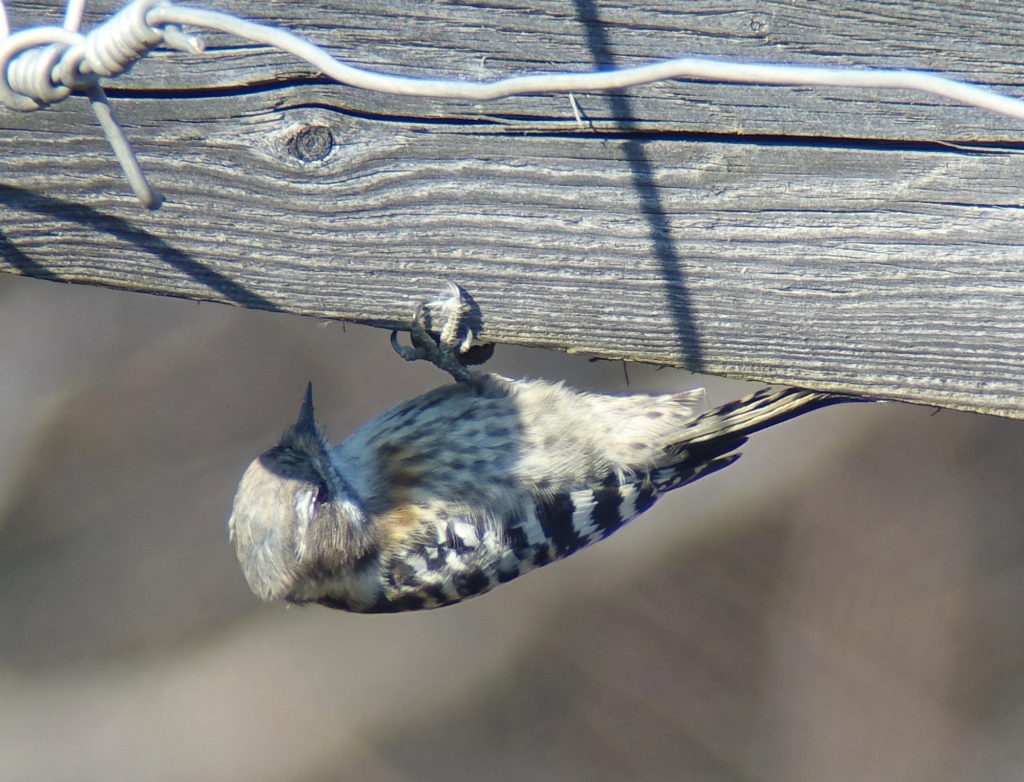 Japanese Pygmy Woodpecker (of subspecies permutatus?), Pipa, Rason © Nial Moores
Japanese Pygmy Woodpecker (of subspecies permutatus?), Pipa, Rason © Nial Moores
Merlin Falco columbarius. One was seen near Manpo on 27th and 28th. Tomek (1999) traced 25 records or so, with most found in winter in the southwestern provinces.
 Merlin, Manpo, Rason © Nial Moores
Merlin, Manpo, Rason © Nial Moores
Chinese Grey Shrike Lanius sphenocercus. A minimum of six were recorded during the present survey, several of which were using the same posts / territories as occupied in July.

 Chinese Grey Shrike, Tumen River, Rason © Nial Moores
Chinese Grey Shrike, Tumen River, Rason © Nial Moores
Willow Tit Poecile montanus. Although the very distinctive, highly nasal “CHAY!!” call was not heard, two especially grey looking birds with extensive wing panels and calls that sounded obviously different from the small numbers of Marsh Tits which were also present (eight logged in total) were presumably of this species. Earlier in 2016, we recorded both Willow and Marsh Tit within 200m or so of the border post on the Chinese side of the Tumen River.
Chinese Nuthatch Sitta villosa . One male was seen well and two other individuals were heard in forest on the 29th.
Alpine Accentor Prunella collaris. A flock of 24 were at the top of Sahyangsan on the 29th.
Siberian Accentor Prunella montanella. A total of 14 were logged during the present survey, including one feeding alongside (and being dwarfed by!) a couple of Alpine Accentors.

 Siberian Accentors, Rason © Nial Moores
Siberian Accentors, Rason © Nial Moores
Water Pipit Anthus spinoletta. A bird seen and heard only in flight west of Sonbong was identified in the field as a Water Pipit based on its large-billed look, faintly marked underparts and calls (mostly given singly, though once given in a series of three notes, more spaced out and squeakier, stronger-sounding than Buff-bellied Pipit). As Water Pipit has not yet been recorded in the DPRK and as we failed to get sound recordings or images, this record is best considered as tentative only.
Grey-capped Greenfinch Chloris sinica. After Eurasian Tree Sparrow, this was the most numerous landbird recorded, with at least 275 logged. There was insufficient time and opportunity to try to identify birds to subspecies.
Red Crossbill Loxia curvirostra. A total of 15 were logged, almost all in overhead flight.
Meadow Bunting Emberiza cioides. Easily the most numerous bunting recorded during the present survey with at least 205 logged. Most/ all were presumed to be of the subspecies wiegoldi based e.g. on the paleness of the heavily streaked upperparts.

 Female (top) and male Meadow Buntings of subspecies wiegoldi, Sonbong, Rason © Nial Moores
Female (top) and male Meadow Buntings of subspecies wiegoldi, Sonbong, Rason © Nial Moores
Ochre-rumped Bunting Emberiza yessoensis. Six individuals of this globally Near Threatened species were logged during the present survey.
 Ochre-rumped Bunting, Uam, Rason © Nial Moores
Ochre-rumped Bunting, Uam, Rason © Nial Moores
A full list has already been provided to Hanns Seidel and a more detailed report will be undertaken when time allows.
All images by Nial Moores were taken with a handheld Sony RXIII through a truly superb Swarovski scope…
Important NOTE:
Birds Korea is dedicated to the conservation of birds and their habitats in Korea and the wider Yellow Sea Eco-region. We are a small non-political conservation organisation that aims to provide best information on birds and their habitats to decision-makers (as well as to the general public), to help inform the conservation process. Birds Korea has an MOU with the Hanns Seidel Foundation (Korea). Dr Nial Moores of Birds Korea was contracted by the Hanns Seidel Foundation to help lead this bird research as part of a much-needed longer-term wetland conservation program supported by e.g. the intergovernmental Ramsar Convention Secretariat and several other international conservation organisations, with the aim of conserving Korean biodiversity in ways that can benefit local communities.
References
- BirdLife International. 2016. IUCN Red List for birds. Downloaded from http://www.birdlife.org on 02/12/2016.
- Brazil, M. 1991. The Birds of Japan. Published by Helm.
- Duckworth, J. W. & Moores, N. 2008. A re-evaluation of the pre-1948 Korean breeding avifauna: correcting a ‘founder-effect’ in perceptions. Forktail 24: 25-27.
- Moores, N. & Kim, A. 2014. The Birds Korea Checklist for the Republic of Korea: 2014.
- Tomek, T. 1999-2002. The birds of North Korea. Acta Zoologica Cracoviensia 42: 1-217; 45: 1-235 (in English).
- UNESCAP & Hanns Seidel Foundation. 2014. Rason Migratory Bird Reserve: Birds and Habitats. Published in Seoul, Korea.
